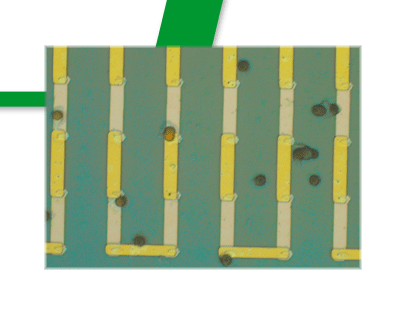
|
||
|
Applications
Bio-sensing and Biomagnetic Applications
A group of researchers at IBM, Columbia , and Stanford recently used Micro Magnetics' micron-size magnetic tunnel junction sensors to successfully detect single magnetic nanoparticles. The group's results demonstrate that the small active area and sensitivity of our SpinTJ (TM) devices make them an ideal fit for use in the emerging applications area of "lab-on-a-chip" detectors. In addition, our SpinTJ sensors show great promise for a number of other cutting-edge biomagnetic applications.
In year 2005, researchers at Brown University used our SpinTJ magnetic sensors to detect single superparamagnetic magnetic beads in solution. This result, published in Applied Physics Letters, was the first successful usage of magnetic tunneling junction sensors in this biological application.
In year
2007, researchers at Micro Magnetics used our SpinTJ magnetic sensors to demonstrate the detection of 2.5 μM target DNA labeled with 16-nm Fe3O4 nanoparticles (NPs). This result, published in Journal of
Applied Physics, shows that MgO-based MTJ sensor arrays are very promising
candidates for future applications involving the accurate detection and
identification of biomolecules tagged with magnetic nanoparticles.
In year
2008, researchers at Brown University used our SpinTJ bridge sensors to quantitatively detect DNA labeled with NPs. This result, published in Applied Physics Letters, shows that the MgO-based MTJ sensor arrays have the sensitivity to detect DNA concentration down to 33pg/μl, which is about 30 times better than traditional detection methods using fluorescent labels, and about 10 times better than the bead array counter sensor (BARC) based on the giant magnetoresistance effect.
Guidelines in Choosing SpinTJ Products for Biomagnetic Applications.
In general, four components are needed: (1) a magnetic sensor, (2) a package on which the sensor is mounted, (3) sensor electronics for powering the sensor and monitoring its response, and (4) a microfluidics circuit that allows the biological solution to flow across the sensing area.
·
The SpinTJ sensors STJ-001 (bare die) can be used for single micron-size magnetic marker detection.
·
For determining the concentration of magnetic markers (nano to micron sizes), low-noise magnetic field sensor STJ-201 (Bare Die) can be used. We can also custom-design and fabricate SpinTJ bridges, with sensing element covering an area from 1 μm2 to 100,000 μm2.
·
For single sub-micron or nano-scale markers, we design and fabricate custom-made sub-micron (down to 100nm) SpinTJ sensors. Call us to discuss your application. We will provide a quote for the service.
·
A single SpinTJ sensor can be mounted (at an additional cost) by our technicians on a package provided by the customer. We typically recommend the use of DIP or SOIC-to-DIP IC packages.
·
We strongly recommend the use of the D-801 (sensor preamplification electronics board). SpinTJ sensors can be directly plugged into the D-801, which also provides better ESD/EOS protection for the sensor. The D-801 amplifies and filters the voltage across the sensor and outputs an analog voltage proportional to the magnetic field. The proprietary design of the D-801 allows power supply noise and other common-mode noise across the sensor to be attenuated by over 100 dB.
·
We can also design and fabricate microfluidic circuits which can be coupled to the SpinTJ sensor(s) according to customer specifications.
Contact Micro Magnetics for more information on the biological applications of our SpinTJ magnetic sensor products.
